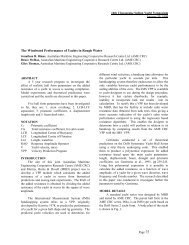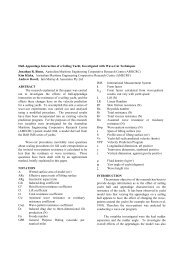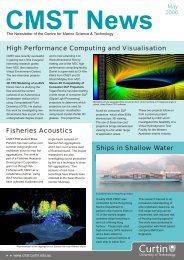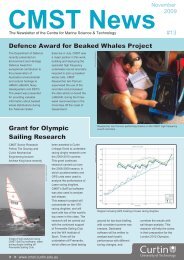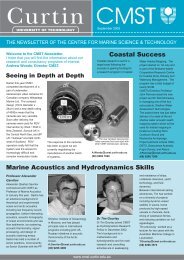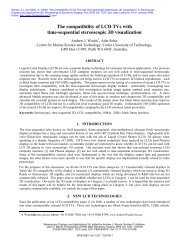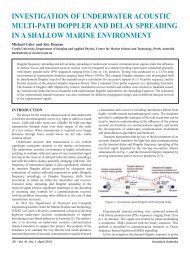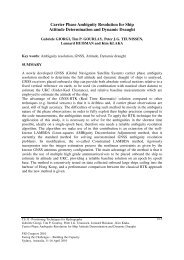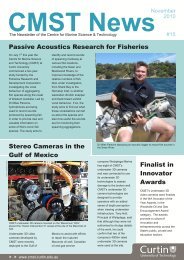AcTUP v2.2l - Centre for Marine Science and Technology
AcTUP v2.2l - Centre for Marine Science and Technology
AcTUP v2.2l - Centre for Marine Science and Technology
You also want an ePaper? Increase the reach of your titles
YUMPU automatically turns print PDFs into web optimized ePapers that Google loves.
<strong>Centre</strong> <strong>for</strong> <strong>Marine</strong> <strong>Science</strong><br />
& <strong>Technology</strong><br />
<strong>AcTUP</strong> <strong>v2.2l</strong> α<br />
Acoustic Toolbox<br />
User-interface & Post-processor<br />
Installation & User Guide<br />
Amos L Maggi & Alec J Duncan<br />
α the l designation indicates the limited or “lite” release of <strong>AcTUP</strong>
CMST <strong>AcTUP</strong> – Installation & User Guide 2<br />
Revision Sheet<br />
Organisation <strong>Centre</strong> <strong>for</strong> <strong>Marine</strong> <strong>Science</strong> <strong>and</strong> <strong>Technology</strong><br />
Project Number<br />
Project Name <strong>AcTUP</strong> Development (on-going)<br />
Document Number<br />
Document Name <strong>AcTUP</strong> – Installation & User Guide<br />
Revision<br />
No.<br />
A (L)<br />
Issue Notes Written<br />
By:<br />
First draft ALM<br />
& AJD<br />
<strong>AcTUP</strong> (LITE) Installation & User Guide.doc<br />
Checked<br />
By:<br />
AJD<br />
Approved<br />
By:<br />
Date<br />
Issued
CMST <strong>AcTUP</strong> – Installation & User Guide 3<br />
<strong>AcTUP</strong> (LITE) Installation & User Guide.doc<br />
TABLE OF CONTENTS<br />
1 INTRODUCTION.......................................................................................................................................... 5<br />
1.1 BACKGROUND.......................................................................................................................................... 5<br />
1.2 DOCUMENT DESCRIPTION......................................................................................................................... 5<br />
1.3 INTENDED AUDIENCE............................................................................................................................... 5<br />
2 WHAT’S NEW............................................................................................................................................... 6<br />
3 INSTALLING & LAUNCHING ACTUP....................................................................................................7<br />
3.1 PREREQUISITES ........................................................................................................................................ 7<br />
3.1.1 MATLAB ............................................................................................................................................ 7<br />
3.1.2 AT....................................................................................................................................................... 7<br />
3.2 DOWNLOADING FILES .............................................................................................................................. 7<br />
3.3 INSTALLING FILES.................................................................................................................................... 7<br />
3.4 SETTING UP ACTUP................................................................................................................................. 8<br />
3.4.1 if you used some other target directory ............................................................................................. 8<br />
3.5 RUNNING ACTUP .................................................................................................................................... 8<br />
3.5.1 end user.............................................................................................................................................. 8<br />
3.5.2 developer............................................................................................................................................ 8<br />
4 USING ACTUP V2.2L ................................................................................................................................... 9<br />
4.1 MAIN MENU............................................................................................................................................ 9<br />
4.1.1 Configure Environment & Propagation Models................................................................................ 9<br />
4.1.2 Select Active Code ~ ............................................................................................................ 9<br />
4.1.3 Run Current Model <strong>for</strong> ACTIVE Propagation code........................................................................... 9<br />
4.1.4 Run Current Model <strong>for</strong> ALL Propagation codes................................................................................ 9<br />
4.1.5 Run Model(s) from File(s) ................................................................................................................. 9<br />
4.1.6 View Log or Environment Files. ...................................................................................................... 10<br />
4.2 ENVIRONMENT & PROPAGATION DEFINITIONS...................................................................................... 10<br />
4.2.1 Load DEFAULT Run Definition ...................................................................................................... 10<br />
4.2.2 Load Run Definition......................................................................................................................... 10<br />
4.2.3 Save Run Definition ......................................................................................................................... 10<br />
4.2.4 Edit Environment ............................................................................................................................. 11<br />
4.2.5 Edit Code-Independent Propagation Parameters............................................................................ 11<br />
4.2.6 Edit Code-Dependent Propagation Parameters .............................................................................. 11<br />
4.2.7 Select Active Code ~ .......................................................................................................... 11<br />
4.3 PLOTTING TOOLS .................................................................................................................................. 12<br />
4.3.1 Amplitude-delay <strong>for</strong> each ray path................................................................................................... 12<br />
4.3.2 Bathymetry....................................................................................................................................... 12<br />
4.3.3 Environment..................................................................................................................................... 12<br />
4.3.4 Green’s function. ............................................................................................................................. 12<br />
4.3.5 Mode locations................................................................................................................................. 12<br />
4.3.6 Mode shapes .................................................................................................................................... 12<br />
4.3.7 Rays ................................................................................................................................................. 12<br />
4.3.8 Reflection coefficient........................................................................................................................ 12<br />
4.3.9 All Transmission loss plots .............................................................................................................. 12<br />
5 ACOUSTIC PROPAGATION CODES ..................................................................................................... 13<br />
5.1 ACOUSTIC TOOLBOX (AT) CODES......................................................................................................... 13<br />
5.1.1 Bounce & Bellhop............................................................................................................................ 13<br />
5.1.2 Kraken, KrakenC & Field................................................................................................................ 13<br />
5.1.3 Scooter & Fields .............................................................................................................................. 14<br />
5.2 RAM..................................................................................................................................................... 15<br />
5.2.1 RAMGeo (v1.5C00.03) .................................................................................................................... 15<br />
5.2.2 RAMSGeo (v0.5C01.01.01).............................................................................................................. 15<br />
5.2.3 Additional modification <strong>and</strong> data h<strong>and</strong>ling ..................................................................................... 15<br />
6 DATA PRODUCTS ..................................................................................................................................... 16<br />
6.1 OUTPUT FILES ....................................................................................................................................... 16
CMST <strong>AcTUP</strong> – Installation & User Guide 4<br />
<strong>AcTUP</strong> (LITE) Installation & User Guide.doc<br />
SUMMARY<br />
This document, Installation & User Guide, is a collection of notes intended<br />
to accelerate the new user’s familiarisation with <strong>AcTUP</strong>. It is not intended<br />
as an exhaustive user manual.<br />
Work carried out by:<br />
Amos L Maggi & Alec J Duncan
CMST <strong>AcTUP</strong> – Installation & User Guide 5<br />
1 introduction<br />
1.1 background<br />
<strong>AcTUP</strong> was initially developed as the “Acoustics Toolbox Front-End” by Alec<br />
Duncan to facilitate the rapid application of, <strong>and</strong> per<strong>for</strong>mance comparisons<br />
between, the different acoustic propagation codes available in Mike Porter’s<br />
Acoustic Toolbox (AT).<br />
This was achieved by providing the user with a unified environment model,<br />
automating the creation of code-specific initialisation files <strong>and</strong> by providing<br />
intelligent guesses <strong>and</strong> selection guidelines <strong>for</strong> code-specific parameters.<br />
The cost of this kind of streamlining is some loss of generality, however users<br />
familiar with the individual propagation codes will find the ability to directly edit<br />
initialisation files from <strong>AcTUP</strong> goes someway to addressing this issue.<br />
Since 2002, the software has steadily grown to include two non-“AT” propagation<br />
codes <strong>and</strong> a number of post-processing tools. The development of <strong>AcTUP</strong> from<br />
version 1.6 to the current version was largely funded by the Defence <strong>Science</strong> &<br />
<strong>Technology</strong> Organisation (DSTO).<br />
1.2 document description<br />
This Installation & User Guide is not intended as a complete user manual.<br />
<strong>AcTUP</strong> is research level code <strong>and</strong> a little clunky at times but the menu driven<br />
<strong>for</strong>mat makes it mostly self-explanatory.<br />
This guide provides:<br />
installation instructions;<br />
an outline of the steps required to generate principle data products where<br />
these are perhaps not obvious;<br />
limited guidance <strong>for</strong> parameter selection in order to successfully generate<br />
these products;<br />
warning of potential traps in the interface<br />
1.3 intended audience<br />
<strong>AcTUP</strong> Project Team<br />
All potential <strong>AcTUP</strong> users – particularly new users<br />
<strong>AcTUP</strong> (LITE) Installation & User Guide.doc
CMST <strong>AcTUP</strong> – Installation & User Guide 6<br />
2 what’s new<br />
<strong>AcTUP</strong> has grown considerably since v1.6 was released. Among the principle<br />
changes are:<br />
a Addition of two modified versions of Mike Collins’ range-dependent PE code<br />
RAM. (The unmodified source code is available from<br />
ftp://ftp.ccs.nrl.navy.mil/pub/ram/RAM/).<br />
b Compatibility with the 2006 release of Mike Porter’s Acoustic Toolbox.<br />
c A redesigned Run Definition class combining model environment <strong>and</strong><br />
propagation parameters into single structure. This offers increased robustness,<br />
facilitating full documentation <strong>and</strong> recovery of all model parameters.<br />
d Ability to set up batch runs of one or more propagation codes using the same<br />
user friendly interface used <strong>for</strong> single runs.<br />
e A redesigned <strong>and</strong> more connected user interface to cope with the significantly<br />
exp<strong>and</strong>ed functionality.<br />
<strong>AcTUP</strong> (LITE) Installation & User Guide.doc
CMST <strong>AcTUP</strong> – Installation & User Guide 7<br />
3 installing & launching <strong>AcTUP</strong><br />
3.1 prerequisites<br />
3.1.1 MATLAB<br />
<strong>AcTUP</strong> v2.2L requires only MATLAB version 6 or later. In addition to this the full<br />
release specification requires the MATLAB Signal Processing Toolbox<br />
Note that version 2.2 was developed using MATLAB R2000a.<br />
3.1.2 AT<br />
Mike Porter’s Acoustic Toolbox <strong>and</strong> versions of RAM modified to work with ActUP<br />
are supplied with <strong>AcTUP</strong> v2.2(L) to simplify installation procedure.<br />
3.2 downloading files<br />
All the files you require <strong>for</strong> installing <strong>AcTUP</strong> v2.2L are available from the <strong>Centre</strong><br />
<strong>for</strong> <strong>Marine</strong> <strong>Science</strong> & <strong>Technology</strong> website @<br />
http://www.cmst.curtin.edu.au/products/actoolbox/index.html<br />
The appropriate link will allow you to download the following self-extracting zip<br />
file:<br />
<strong>AcTUP</strong> v2.2 lite.exe<br />
3.3 installing files<br />
To install <strong>AcTUP</strong> v2.2(L) simply run the executable above.<br />
After extract the topmost <strong>AcTUP</strong> directory will locate directly below the default<br />
target directory as shown in the figure below:<br />
Below the target directory, your directory structure (no matter what target was<br />
selected) will look like:<br />
working directory<br />
You should AVOID editing or deleting installed directory names.<br />
<strong>AcTUP</strong> (LITE) Installation & User Guide.doc<br />
upper directory <strong>for</strong><br />
output files<br />
default location <strong>for</strong><br />
saving run definitions<br />
&<br />
model source signals<br />
Acoustic Toolbox code
CMST <strong>AcTUP</strong> – Installation & User Guide 8<br />
3.4 setting up <strong>AcTUP</strong><br />
You only need to complete the following instructions if you DID NOT use the<br />
default target directory in the installation process.<br />
3.4.1 if you used some other target directory<br />
Navigate to the folder<br />
C:\Program Files\CMST Software\<strong>AcTUP</strong> v2.2L\<strong>AcTUP</strong>\Source<br />
Open<br />
GetAcDirectoryInfo.m<br />
Edit the line …<br />
Top = 'C:\Program Files\CMST Software\<strong>AcTUP</strong> v2.2L\';<br />
… to reflect the correct location of the <strong>AcTUP</strong> v2.2L directory.<br />
Save <strong>and</strong> close this file.<br />
Now point MATLAB at the working directory by<br />
3.5 running <strong>AcTUP</strong><br />
3.5.1 end user<br />
In order to run <strong>AcTUP</strong> you must point MATLAB at the working directory <strong>AcTUP</strong>.<br />
You must then run the top level m file actup.m.<br />
The example below is <strong>for</strong> the default installation case.<br />
>> cd(‘C:\Program Files\CMST Software\<strong>AcTUP</strong> v2.2L\<strong>AcTUP</strong>’);<br />
>> actup<br />
Note that if <strong>AcTUP</strong> is used often the working directory will probably spend a lot of<br />
time in the current directory drop box at the top of the comm<strong>and</strong> window <strong>for</strong> rapid<br />
selection.<br />
Alternatively, the two lines above can be inserted in to a MATLAB script or<br />
function somewhere on the MATLAB path allowing the cd <strong>and</strong> launch comm<strong>and</strong> to<br />
be executed in one line.<br />
Note that it is not sufficient (<strong>and</strong> not recommended) that you place the working<br />
directory permanently on the MATLAB path.<br />
3.5.2 developer<br />
This is NOT recommended <strong>for</strong> driving the application but while developing <strong>AcTUP</strong>,<br />
it is more conveniet to run from the source subdirectory.<br />
>> cd(‘C:\Program Files\CMST Software\<strong>AcTUP</strong> v2.2L\<strong>AcTUP</strong>\Source’);<br />
>> act<br />
<strong>AcTUP</strong> (LITE) Installation & User Guide.doc
CMST <strong>AcTUP</strong> – Installation & User Guide 9<br />
4 using <strong>AcTUP</strong> <strong>v2.2l</strong><br />
The menu driven system is largely self-explanatory but some introductory notes<br />
are provided below to kick-start the familiarisation process <strong>and</strong> to help the user<br />
avoid pitfalls.<br />
4.1 Main Menu<br />
4.1.1 Configure Environment & Propagation<br />
Models<br />
Launches another menu which allows the user<br />
to define the model environment, set basic<br />
propagation parameters, to set parameters<br />
specific to the available propagation codes, to<br />
save all environment <strong>and</strong> propagation model<br />
parameters as a single Run Definition, <strong>and</strong> to<br />
load previously saved Run Definitions.<br />
4.1.2 Select Active Code ~ <br />
Selects which of the available codes is used in<br />
modelling propagation when the button below<br />
this one is selected (see 4.1.3).<br />
4.1.3 Run Current Model <strong>for</strong> ACTIVE<br />
Propagation code.<br />
Runs the environment/propagation model<br />
currently in memory using the selected<br />
propagation code (see 4.1.2). Note <strong>AcTUP</strong><br />
does not check whether the code-specific<br />
parameters have been set <strong>for</strong> the selected<br />
propagation code.<br />
4.1.4 Run Current Model <strong>for</strong> ALL Propagation codes.<br />
Runs the environment/propagation model currently in memory using all available<br />
propagation codes. Note that in this mode Bounce <strong>and</strong> Fields are only run in<br />
conjunction with Bellhop <strong>and</strong> Scooter respectively.<br />
Note <strong>AcTUP</strong> does not check whether the all code-specific parameters have been<br />
set. This would be rather difficult to do anyway since Run Definitions are rarely<br />
built from scratch. They are often built from previously saved Definitions. It is<br />
impractical <strong>and</strong> perhaps impossible to track environment or propagation model<br />
edit <strong>and</strong> from these determine algorithmically whether previously defined codespecific<br />
parameters are still appropriate.<br />
4.1.5 Run Model(s) from File(s)<br />
This options enables batch mode processing. The user is prompted to select a<br />
directory containing one or more Run Definitions. <strong>AcTUP</strong> will sequentially load <strong>and</strong><br />
run each Run Definition file. For each Run Definition file, the propagation code<br />
applied is which was active (4.1.2) at the time it was last saved to disk. Currently<br />
only one active propagation code is selectable at any one time so that in order to<br />
run multiple propagation codes <strong>for</strong> the same Run Definition from file, the user<br />
must save a copy of same the Run Definition <strong>for</strong> each propagation code required.<br />
<strong>AcTUP</strong> (LITE) Installation & User Guide.doc
CMST <strong>AcTUP</strong> – Installation & User Guide 10<br />
4.1.6 View Log or Environment Files.<br />
Allows user to open <strong>and</strong> view log (.prn) <strong>and</strong> environment definition (.env) files.<br />
The log files are text files which contain a log of the comm<strong>and</strong> line instructions<br />
issued by <strong>AcTUP</strong> <strong>and</strong> any errors generated by them. (Note in some cases MATLAB<br />
comm<strong>and</strong>s copyfile <strong>and</strong> movefile have been used to replace comm<strong>and</strong> line<br />
copy <strong>and</strong> move <strong>and</strong> so do not generate entries in the log file).<br />
The environment files are somewhat of a misnomer <strong>and</strong> an artefact from early<br />
versions of <strong>AcTUP</strong>.<br />
These are in fact (renamed) copies of the configuration files accessed by the<br />
propagation codes <strong>and</strong> contain propagation model parameters as well as<br />
environment model parameters.<br />
Additionally, .env does not describe a single <strong>for</strong>mat. One of the motivations <strong>for</strong><br />
<strong>AcTUP</strong> is that each propagation code uses quite data <strong>and</strong> data <strong>for</strong>mats. These are<br />
written to the .env files <strong>and</strong> then copied to the st<strong>and</strong>ard configuration file name<br />
<strong>for</strong> the active propagation code just prior to execution. The .env files are stored<br />
with the other output<br />
4.2 Environment & Propagation Definitions<br />
4.2.1 Load DEFAULT Run Definition<br />
The default configuration has preloaded codespecific<br />
parameters <strong>for</strong> each available<br />
propagation code, <strong>and</strong> can be run as a first test<br />
after installation.<br />
4.2.2 Load Run Definition<br />
To date there is no specific filename extension<br />
identifying Run Definition objects <strong>and</strong> instead<br />
we use the default .mat extension denoting the<br />
<strong>for</strong>mat in which the Run Definition is saved.<br />
This <strong>and</strong> the way environment <strong>and</strong> propagation<br />
models are h<strong>and</strong>led may change in future<br />
versions.<br />
Note that backward compatibility has been<br />
maintained. <strong>AcTUP</strong> 2.2 will seamlessly load Run<br />
Definitions saved by previous versions then<br />
create <strong>and</strong> fill missing fields with default<br />
values. While the converted Run Definition may<br />
run with previously unavailable code options,<br />
results may not be satisfactory.<br />
4.2.3 Save Run Definition<br />
While you may use a different extension from .mat it is advised that you stick<br />
with this <strong>for</strong>mat. If you save both input <strong>and</strong> output files in an areas designated <strong>for</strong><br />
<strong>AcTUP</strong> modelling then there is no need to distinguish these .mat files from any<br />
others since they are the only ones used by <strong>AcTUP</strong>.<br />
<strong>AcTUP</strong> (LITE) Installation & User Guide.doc
CMST <strong>AcTUP</strong> – Installation & User Guide 11<br />
4.2.4 Edit Environment<br />
This launches an interface to edit the model environment. This consists of an<br />
array of range-independent Environment objects, each defined at a specific range.<br />
The range-independent codes (all codes, except RAM* in this version) only use<br />
the first element of the Environment array.<br />
Each Environment object is a collection of range independent layers of acoustic<br />
media. The first layer is always the water column <strong>and</strong> the second layer is always<br />
the upper-most layer of the substrate. Each layer consists of lists of depth- (z-)<br />
dependent properties which must be specified.<br />
Bathymetry is currently specified in the propagation model. It is used to specify<br />
the depth at which the upper interface of the 2 nd acoustic medium layer occurs<br />
relative to the upper surface of the first (water) layer.<br />
Currently the Environment object array is limited in such a way that each<br />
component Environment object must contain the same number of layers.<br />
4.2.5 Edit Code-Independent Propagation Parameters<br />
Basic parameters defining the propagation scenario are specified here. Along with<br />
the environmental model, these parameters <strong>for</strong>m a basis <strong>for</strong> configuring runs by<br />
the different propagation codes, <strong>and</strong> in some cases (e.g. Bounce, Kraken,<br />
Scooter) completely specify the run.<br />
4.2.6 Edit Code-Dependent Propagation Parameters<br />
In<strong>for</strong>mation additional to that provided above is required <strong>for</strong> some codes (i.e.<br />
Bellhop, KrakenC, RAMGeo <strong>and</strong> RAMSGeo). Here the user can set appropriate<br />
parameters values <strong>for</strong> each code. Note that most of the values <strong>for</strong> RAMGeo <strong>and</strong><br />
RAMSGeo are common <strong>and</strong> editing a parameter in one of these effectively edits<br />
that parameter <strong>for</strong> both codes. (The interface design has been compromised <strong>for</strong><br />
the sake of development time <strong>and</strong> contains artefacts of earlier [unreleased]<br />
versions. Some streamlining may occur in subsequent versions).<br />
Note that when a Run Definition is saved, all the code-dependent parameters are<br />
saved with it irrespective of which code is selected as active.<br />
4.2.7 Select Active Code ~ <br />
See 4.1.2.<br />
<strong>AcTUP</strong> (LITE) Installation & User Guide.doc
CMST <strong>AcTUP</strong> – Installation & User Guide 12<br />
4.3 Plotting Tools<br />
These are fairly self explanatory <strong>and</strong> the following<br />
is merely a brief description of which data files are<br />
accessed <strong>and</strong> which codes produce those files.<br />
4.3.1 Amplitude-delay <strong>for</strong> each ray path.<br />
Plot the data from .arr files output by Bellhop in<br />
“A” mode<br />
4.3.2 Bathymetry.<br />
Plots bathymetry data from bathymetry files in the<br />
input <strong>for</strong>mat required by <strong>AcTUP</strong><br />
ascii <strong>for</strong>mat:<br />
row # <strong>for</strong>mat comments<br />
1 %d number of points<br />
2 to N+1 %f %f r [km] z [m]<br />
4.3.3 Environment<br />
Plots water <strong>and</strong> substrate physical <strong>and</strong> acoustic<br />
parameter profiles <strong>for</strong> the currently loaded<br />
environment model.<br />
4.3.4 Green’s function.<br />
Plots the results generated by Scooter (.grn files).<br />
4.3.5 Mode locations.<br />
Uses output from Kraken & KrakenC.<br />
4.3.6 Mode shapes<br />
Uses output from Kraken & KrakenC.<br />
4.3.7 Rays<br />
Plots ray paths generated by Bellhop in “R” mode (.ray files)<br />
4.3.8 Reflection coefficient<br />
Plot the data from .brc files output by Bounce.<br />
4.3.9 All Transmission loss plots<br />
Plots output from .shd files generated by Bellhop (C, S & I modes), Kraken,<br />
KrakenC, Fields, <strong>and</strong> RAM* (see 5.2).<br />
<strong>AcTUP</strong> (LITE) Installation & User Guide.doc
CMST <strong>AcTUP</strong> – Installation & User Guide 13<br />
5 Acoustic Propagation Codes<br />
5.1 Acoustic Toolbox (AT) Codes<br />
The following components of Mike Porter’s Acoustic Toolbox are supported <strong>and</strong><br />
directly available from HLS Research.<br />
The version supplied <strong>and</strong> tested with <strong>AcTUP</strong> v2.2 is that released by Mike Porter in<br />
early 2006.<br />
For further details, please refer to the HLS Research site:<br />
http://www.hlsresearch.com/oalib/Modes/AcousticsToolbox/<br />
For an excellent reference that covers the theoretical background of all the<br />
propagation codes used by ActUP, see:<br />
Jensen et al. (1994) Computational Ocean Acoustics, AIP Press, New York.<br />
5.1.1 Bounce & Bellhop<br />
Bounce calculates reflection coefficients at the lower water column interface. In<br />
<strong>AcTUP</strong> it can be run independently or in t<strong>and</strong>em with Bellhop which uses the<br />
reflection coefficient output to model either:<br />
Beam/Ray paths<br />
Amplitude <strong>and</strong> Delay of arrivals at specified field points, or<br />
Coherent, semicoherent or incoherent transmission loss<br />
Bellhop is a beam-tracing program that can include range dependent bathymetry<br />
(but not sound speed). Beam tracing is similar in principle to ray tracing but<br />
traces the paths of finite width beams rather than infinitesimal width rays. This<br />
reduces problems caused by ray theory artefacts such as caustics <strong>and</strong> shadow<br />
zones. Bellhop can use beams with a Gaussian intensity profile, or geometric<br />
beams which produce the same result as a st<strong>and</strong>ard ray trace. Bellhop is<br />
inherently a high frequency code, <strong>and</strong> although its useful frequency range extends<br />
lower than st<strong>and</strong>ard ray trace programs, it should be used with extreme caution in<br />
situations where the water depth or the size of any significant feature in the<br />
sound speed profile is less than 20 wavelengths.<br />
5.1.2 Kraken, KrakenC & Field<br />
Kraken finds the normal modes <strong>for</strong> the model propagation environment using real<br />
arithmetic <strong>and</strong> estimates the attenuation by a perturbation technique. This<br />
method works well <strong>for</strong> layered fluid seabeds <strong>and</strong> can h<strong>and</strong>le an elastic lower<br />
halfspace (i.e. a halfspace with a significant shear speed). It can’t cope with<br />
elastic intermediate layers. The normal modes only account <strong>for</strong> energy that is<br />
trapped in the waveguide <strong>and</strong> there<strong>for</strong>e this method is inaccurate at short range<br />
where the effect of untrapped energy is significant.<br />
KrakenC finds the normal modes in the complex wavenumber plane, which allows<br />
it to deal with elastic seabed layers, <strong>and</strong> to include the effects of leaky modes,<br />
which account <strong>for</strong> some of the untrapped energy. This makes it more accurate<br />
than Kraken at short range. However, finding modes in the complex plane is much<br />
more difficult than finding them on the real axis which makes KrakenC prone to<br />
missing some of the modes, leading to inaccurate results. Use with caution!<br />
Field uses the normal modes calculated by either of these programs to determine<br />
the transmission loss at the specified field points.<br />
<strong>AcTUP</strong> automatically runs Field immediately following either Kraken or KrakenC.<br />
This is a very efficient way of calculating low frequency transmission loss at long<br />
<strong>AcTUP</strong> (LITE) Installation & User Guide.doc
CMST <strong>AcTUP</strong> – Installation & User Guide 14<br />
ranges, as the modes only have to be calculated once, after which the<br />
transmission loss can easily be computed at any desired range. However, the<br />
number of modes increases with increasing frequency, making normal mode<br />
methods unsuitable <strong>for</strong> modelling propagation in situations where the waveguide<br />
is many acoustic wavelengths deep.<br />
In future versions Field may be offered as a separate option to make use of<br />
existing mode files.<br />
Range dependent problems can be h<strong>and</strong>led by computing the normal modes at<br />
different ranges <strong>and</strong> then using adiabatic or coupled mode theory to calculate how<br />
the modes at one range couple to the modes at the next range. This capability is<br />
not currently supported by <strong>AcTUP</strong><br />
5.1.3 Scooter & Fields<br />
Scooter calculates the depth-dependent Green’s function <strong>for</strong> the model<br />
environment.<br />
Fields (not Field) integrates the resultant Green’s function results (in .grn files) to<br />
determine the transmission loss by using an FFT. This is the fast field technique.<br />
This method of calculating transmission loss accounts <strong>for</strong> all the acoustic energy,<br />
whether trapped or not, <strong>and</strong> does not rely on the less than 100% reliable process<br />
of finding normal modes. It can also cope quite happily with layered elastic<br />
seabeds, <strong>and</strong> even model boundary interface waves. It is there<strong>for</strong>e both more<br />
accurate <strong>and</strong> more reliable than the normal mode method <strong>and</strong> is, far <strong>and</strong> away,<br />
the preferred technique <strong>for</strong> low frequency, short range, range independent<br />
problems. It is, however, much more computationally intensive than normal<br />
modes <strong>for</strong> long-range problems, <strong>and</strong> the computational load increases rapidly with<br />
increasing frequency.<br />
In <strong>AcTUP</strong> Scooter <strong>and</strong> Fields can be run in sequence automatically<br />
(Scooter+Fields) or manually. The later is useful when high-resolution range data<br />
dr is only required about small regions ∆r about a number of ranges {ri} where<br />
|ri+1 - ri| >> ∆r, while maintaining workable file sizes.<br />
When the sequence is run automatically, it is done so <strong>for</strong> each specified frequency<br />
in turn. Field uses the .grn file just created by Scooter <strong>and</strong> the field points<br />
specified by the receiver location in the Code-Independent parameter set.<br />
Care needs to be taken when Fields is run manually because Fields needs very<br />
little in<strong>for</strong>mation. In fact it can be run without the same Run Definition<br />
(environment + propagation parameters) previously used by Scooter.<br />
When run manually, the user must first launch ”Edit Code-Dependent Parameters”<br />
<strong>for</strong> Fields. Here the user specifies a group of target .grn files by choosing one of<br />
the group interactively. <strong>AcTUP</strong> will then locate all .grn files in the same folder that<br />
match the base filename prefix excluding the frequency tag. The user is then<br />
prompted to specify the field point grid <strong>for</strong> the TL calculation. The suggested<br />
parameters appearing on the Fields dialog box will be based on the .grn file<br />
contents <strong>and</strong> the receiver locations in the Code-Independent parameters. It is<br />
recommended although not absolutely necessary that the Run Definition used to<br />
generate Scooter be loaded <strong>for</strong> be<strong>for</strong>e setting up launching Fields.<br />
<strong>AcTUP</strong> (LITE) Installation & User Guide.doc
CMST <strong>AcTUP</strong> – Installation & User Guide 15<br />
5.2 RAM<br />
Two modified versions of Mike Collins’ Range-dependent Acoustic Model (RAM)<br />
have been integrated into the AcTUI framework. RAM is a parabolic equation (PE)<br />
code that uses a split-step Padé algorithm to achieve high efficiency <strong>and</strong> the<br />
ability to model propagation at large angles from the horizontal (the usual<br />
limitation of PE codes). There is a trade-off between the angular range <strong>and</strong> the<br />
speed of computation that is governed by the number of terms the user specifies<br />
<strong>for</strong> the Padé approximation – the more terms, the wider the angle, but the slower<br />
the code runs.<br />
RAM is capable of modelling low frequency propagation in fully range dependent<br />
environments (i.e. range dependent bathymetry <strong>and</strong> sound speed), <strong>and</strong> this<br />
capability is fully supported by <strong>AcTUP</strong>.<br />
5.2.1 RAMGeo (v1.5C00.03)<br />
This is a CMST version based on Mike Collins’ RAMGeo version 1.5.<br />
It has been modified to output complex transmission loss data as well as the<br />
st<strong>and</strong>ard magnitude only files. Additional files output are:<br />
tl.pgrid Complex pressure analogue to tl.grid<br />
tl.pline Complex pressure analogue to tl.line<br />
Additional minor modifications include some error flags which enable AcTUI <strong>and</strong><br />
the user to better identify some run time errors.<br />
5.2.2 RAMSGeo (v0.5C01.01.01)<br />
This is a CMST version based on Mike Collins’ RAMS version 0.5 <strong>and</strong> the RAMGeo<br />
version discussed in the previous section.<br />
Mike Collins’ elastic substrate version of RAM has been modified so that it uses the<br />
same (bathymetry datum) substrate profile specification model as RAMGeo.<br />
5.2.3 Additional modification <strong>and</strong> data h<strong>and</strong>ling<br />
When these two versions are run under <strong>AcTUP</strong>, the .pgrid files are translated <strong>and</strong><br />
written to shade <strong>for</strong>mat files (.shd) used by the other (AcT) models.<br />
Code <strong>for</strong> conversion <strong>and</strong> reading shade files in <strong>AcTUP</strong> has been modified to cope<br />
with the rare but conceivable case where the (complex) TL record length can<br />
exceed twice the length (in number not necessarily bytes) of the (real) range<br />
vector record. Generally only a risk in model propagation planes with unusually<br />
high aspect ratios.<br />
<strong>AcTUP</strong> (LITE) Installation & User Guide.doc
CMST <strong>AcTUP</strong> – Installation & User Guide 16<br />
6 Data Products<br />
6.1 Output Files<br />
extension description <strong>for</strong>mat produced by<br />
.arr Amplitude <strong>and</strong> time-of-flight data as<br />
well as other ray parameters <strong>for</strong><br />
arrivals at field point.<br />
.brc Bottom reflection coefficient as a<br />
function of incident angle<br />
.grn Depth-dependent Green’s function<br />
solutions<br />
<strong>AcTUP</strong> (LITE) Installation & User Guide.doc<br />
ascii Bellhop<br />
ascii Bounce<br />
binary Scooter<br />
.mod Mode solutions binary Kraken<br />
KrakenC<br />
.ray Ray trace output Bellhop<br />
.shd Complex transmission loss as a<br />
function of depth <strong>and</strong> range<br />
binary Bellhop<br />
Field<br />
Fields<br />
<strong>AcTUP</strong>



